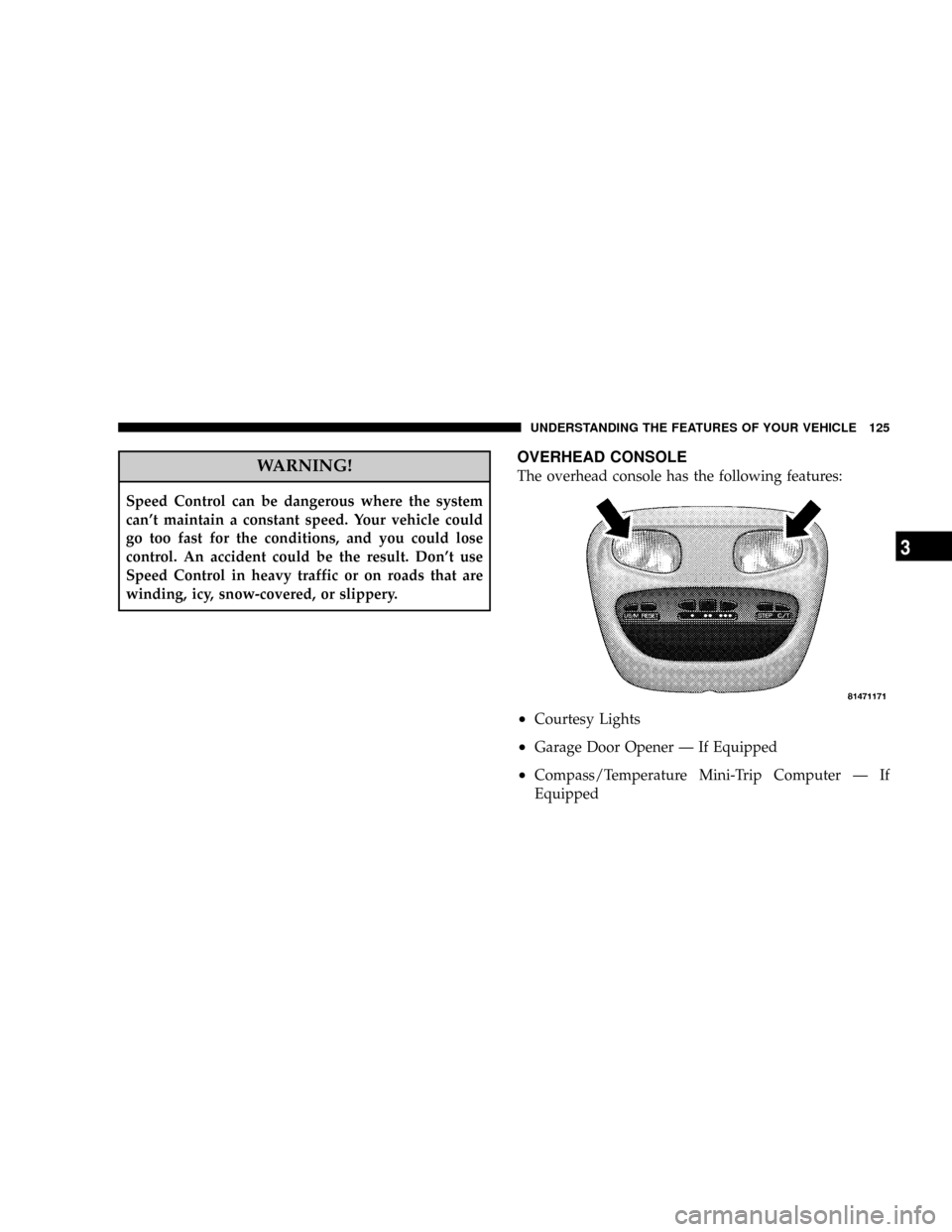light DODGE DAKOTA 2008 3.G Owner's Guide
[x] Cancel search | Manufacturer: DODGE, Model Year: 2008, Model line: DAKOTA, Model: DODGE DAKOTA 2008 3.GPages: 426, PDF Size: 6.39 MB
Page 125 of 426

WARNING!
Speed Control can be dangerous where the system
can't maintain a constant speed. Your vehicle could
go too fast for the conditions, and you could lose
control. An accident could be the result. Don't use
Speed Control in heavy traffic or on roads that are
winding, icy, snow-covered, or slippery.
OVERHEAD CONSOLE
The overhead console has the following features:
²Courtesy Lights
²Garage Door Opener Ð If Equipped
²Compass/Temperature Mini-Trip Computer Ð If
Equipped
UNDERSTANDING THE FEATURES OF YOUR VEHICLE 125
3
Page 126 of 426

Courtesy/Reading Lights
Near the front of the console are two courtesy/reading
lights.
Both lights illuminate as courtesy lights when a door is
opened, when the dimmer control is rotated to the
courtesy light position (fully upward position), or when
the UNLOCK button is pressed on the Remote Keyless
Entry transmitter, if so equipped. These lights are also
operated individually as reading lights by pressing the
recessed area of the corresponding lens.
NOTE:The courtesy/reading lights will remain on until
the switch is pressed a second time, so be sure they have
been turned off before leaving the vehicle. If the interior
lights are left on after the vehicle is turned OFF, they will
extinguish after 8 minutes.
COMPASS/TEMPERATURE MINI-TRIP COMPUTER
This feature allows you to choose between a compass/
temperature display and one of four trip conditions being
monitored.
US/M Button
Use this button to change the display from U.S. to metric
measurement units.
126 UNDERSTANDING THE FEATURES OF YOUR VEHICLE
Page 132 of 426

To set the variance: Turn the ignition ON and set the
display to ªCompass/Temperature.º Press and hold the
RESET button approximately five seconds. The last vari-
ance zone number will be displayed. Press the STEP
button to select the new variance zone and press the
RESET button to resume normal operation.
Outside Temperature
Because the ambient temperature sensor is located un-
derhood, engine temperature can influence the displayed
temperature, therefore, temperature readings are slowly
updated when the vehicle speed is below 20 mph (30
km/h) or during stop and go driving.
GARAGE DOOR OPENER Ð IF EQUIPPED
HomeLinktreplaces up to three remote controls (hand
held transmitters) that operate devices such as garage
door openers, motorized gates, lighting, or home security
systems. The HomeLinktunit operates off of your vehi-
cle's battery.
NOTE:HomeLinktis disabled when the Vehicle Theft
Alarm is active.
132 UNDERSTANDING THE FEATURES OF YOUR VEHICLE
Page 137 of 426

Then proceed with Step 4 under ªProgramming
HomeLink.º earlier in this section.
Using HomeLinkT
To operate, simply press and release the programmed
HomeLinktbutton. Activation will now occur for the
trained device (i.e. garage door opener, gate operator,
security system, entry door lock, home/office lighting,
etc. The hand-held transmitter of the device may also be
used at any time.
Reprogramming a Single HomeLinkTButton
To re-program a channel that has been previously
trained, follow these steps:
1. Turn the ignition switch to the ON/RUN position.
2. Press and hold the desired HomeLinktbutton for 20
seconds until the indicator(s) starts to flash.Do not
release the button.3.Without releasing the button,proceed with PRO-
GRAMMING HOMELINK Step #2 and follow all remain-
ing steps.
Security
It is advised to erase all channels before you sell or turn
in your vehicle.
To do this, press and hold the two outside buttons for 20
seconds until the indicators begin to flash. Note that all
channels will be erased. Individual channels cannot be
erased.
The HomeLinktUniversal Transceiver is disabled when
the Vehicle Theft Alarm is active.
Troubleshooting Tips
If you are having trouble programming HomeLinkt, here
are some of the most common solutions:
²Replace the battery in the original transmitter.
UNDERSTANDING THE FEATURES OF YOUR VEHICLE 137
3
Page 138 of 426

²Press the Learn Button on the Garage Door Opener to
complete the training for Rolling Code.
²Did you unplug the device for training, and remember
to plug it back in?
If you are have any problems, or require assistance,
please call toll-free 1±800±355±3515 or, on the Internet at
www.HomeLink.com for information or assistance.
General Information
This device complies with FCC rules part 15 and Industry
Canada RSS-210. Operation is subject to the following
two conditions:
1. This device may not cause harmful interference
2. This device must accept any interference that may be
received including interference that may cause undesired
operationNOTE:The transmitter has been tested and it complies
with FCC and IC rules. Changes or modifications not
expressly approved by the party responsible for compli-
ance could void the user 's authority to operate the
device.
The term ªIC:º before the certification/registration num-
ber only signifies that Industry Canada technical specifi-
cations were met.ELECTRICAL POWER OUTLETS
This vehicle has two 12V auxiliary power outlets that can
provide up to 20 Amps of current for accessories de-
signed for use with standard power outlet adapters. The
outlets are located in the instrument panel, below the
temperature control setting knob, and the other inside the
full - size center console. When the optional Cigar Lighter
heating element is used, it heats when pushed in and
138 UNDERSTANDING THE FEATURES OF YOUR VEHICLE
Page 139 of 426

pops out automatically when ready for use.To preserve
the heating element, do not hold the lighter in the
heating position.
The instrument panel outlet can be reconfigured by the
customer to operate only when the ignition is On (switch
battery fed) or with the ignition switch On/Off (battery
fed) to allow for cellular phone charging and/or opera-
tion while the ignition is Off. This can be done by moving
the power outlet (switchable) fuse (fuse #22) from the
inboard position to the outboard position.
NOTE:All accessories connected to these outlets should
be removed or turned OFF when the vehicle is not in use
to protect the battery against discharge (unless the cus-
tomer has reconfigured the fuse block to switched battery
feed).Electrical Outlet Use With Engine OFF
(Battery Fed Configuration)
CAUTION!
²Many accessories that can be plugged in draw
power from the vehicle's battery, even when not in
use (i.e. cellular phones, etc.). Eventually, if
plugged in long enough, the vehicle's battery will
discharge sufficiently to degrade battery life
and/or prevent engine starting.
²Accessories that draw higher power (i.e. coolers,
vacuum cleaners, lights, etc.), will discharge the
battery even more quickly. Use these only inter-
mittently and with greater caution.
²After the use of high power draw accessories, or
long periods of the vehicle not being started (with
accessories still plugged in), the vehicle must be
driven a sufficient length of time to allow the
generator to recharge the vehicle's battery.
UNDERSTANDING THE FEATURES OF YOUR VEHICLE 139
3
Page 145 of 426

REAR WINDOW FEATURES
Rear Window Defroster ± If Equipped
CAUTION!
Use care when washing the inside of the rear window
to prevent damage to heating elements. Use a soft
cloth and a mild washing solution, wiping parallel to
the heating elements. Also, keep all objects a safe
distance from the window to prevent damaging the
heating elements.A push-button type switch is located on the right
side of the control below the A/C (Snowflake)
button. Pressing the switch will turn on the Rear Window
Defroster. A light above the Rear Window Defroster
symbol will illuminate to indicate the Rear Window
Defroster is On. Pushing the button again will turn the
Rear Window Defroster Off prior to the time-out. The
Rear Window Defroster will turn off automatically after
15 minutes after the first push, 10 minutes after the
second push all within the same ignition cycle. To
prevent excessive battery drain, use the rear defroster
only when the engine is running.
UNDERSTANDING THE FEATURES OF YOUR VEHICLE 145
3
Page 147 of 426

3. Lift the tailgate off of the pivot on the passenger side
by pulling upward and rearward at the same time.
4. Slide the tailgate to the passenger side while making
sure clearance from the box and taillight is maintained.
To reinstall the tailgate, do the following:
1. Slide the tailgate onto the driver's side pivot.2. Hold the tailgate at a 45É angle and insert it into the
passenger side pivot.
3. Clip the cables to the box.
Two Position Tailgate / Upper Load Platform
Your tailgate can be opened to the full open or the partial
open position. The partial open position is for loading
objects longer than the length of the bed (sheets of
plywood, etc.) by creating an upper load platform:
1. Install lumber
²Place lumber across the box in the indentations
provided above the wheel housings and in the
bulkhead dividers to form the floor. There are
indents in the sheet metal (or bed liner if equipped)
on the inner side of the box in front (Club Cab only)
and behind both wheel housings.
UNDERSTANDING THE FEATURES OF YOUR VEHICLE 147
3
Page 148 of 426

2. Secure the tailgate in the partially open position:
²Open the tailgate slightly.
²Snap the tailgate support cable between the cable
guide and the tailgate bumper. Do this on both sides
of the tailgate.To return the tailgate to the full open position:
²Lift up on the tailgate.
²Remove both cables from between the cable guides
and the tailgate bumpers and lower the tailgate.
148 UNDERSTANDING THE FEATURES OF YOUR VEHICLE
Page 156 of 426

INSTRUMENTS AND CONTROLS
1 Ð Headlight Switch 6 Ð Glove Box 11 Ð Transfer Case Switch*
2 Ð Air Outlets 7 Ð Radio 12 Ð Speed Control Switches
3 Ð Demister Outlets 8 Ð Climate Controls 13 Ð Hood Release
4 Ð Instrument Cluster 9 Ð Power Outlet 14 Ð Parking Brake Release
5 Ð Airbags 10 Ð Heated Seat Switches* * If Equipped 156 INSTRUMENT PANEL AND CONTROLS